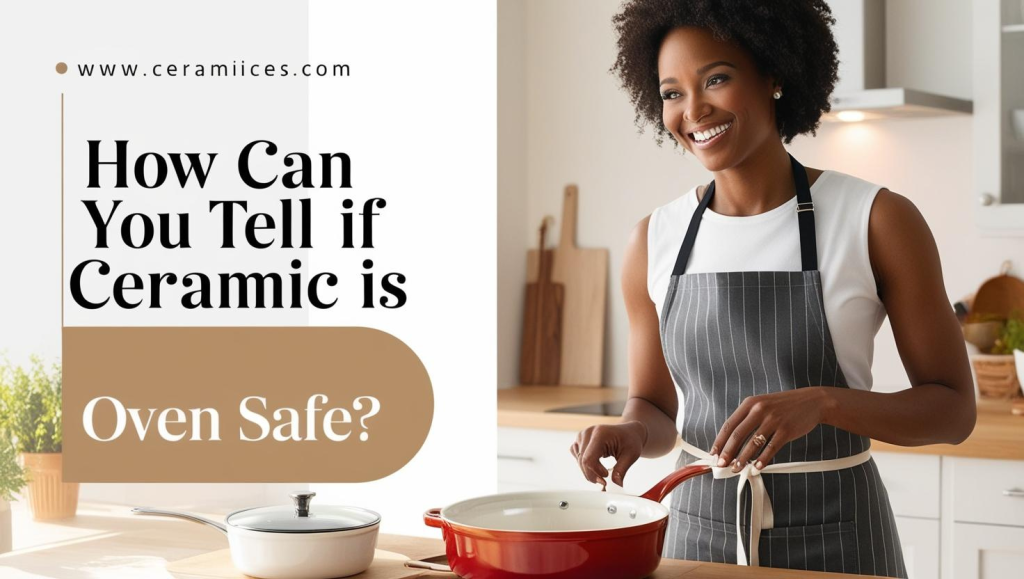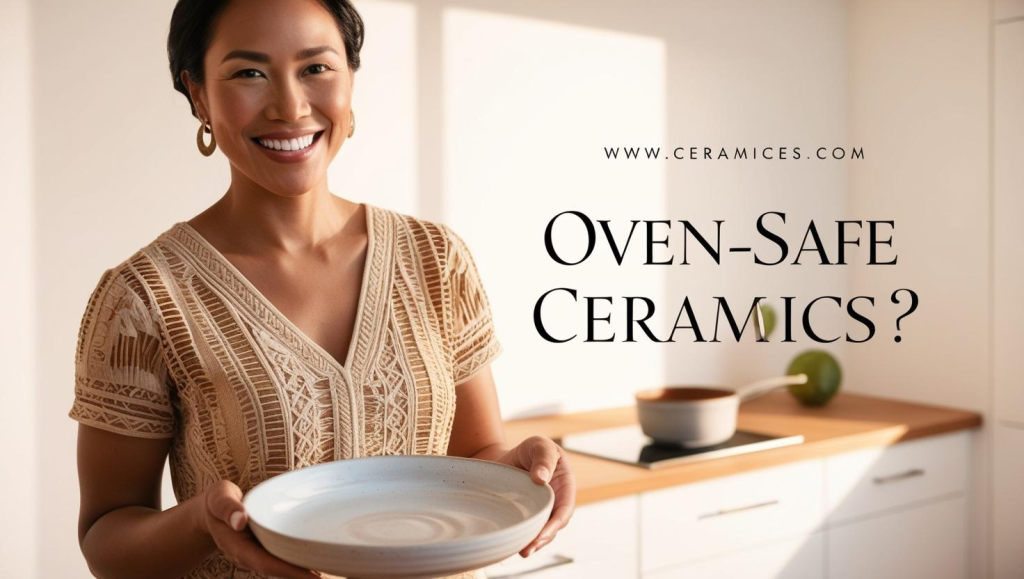Ceramic is a versatile and durable material commonly used in kitchenware, from baking dishes and casserole pots to mugs and plates. Its heat resistance and aesthetic appeal make it a popular choice for both cooking and serving. However, not all ceramic items are suitable for oven use, and using the wrong type of ceramic in the oven can lead to cracking, breaking, or even safety hazards. This raises an important question: “How can you tell if ceramic is oven safe?” In this comprehensive guide, we’ll explore how to identify oven-safe ceramic, the factors that determine its heat resistance, and tips for safely using ceramic in the oven. We’ll also answer 10 frequently asked questions to help you confidently use ceramic cookware in your kitchen.
Understanding Ceramic: Composition and Heat Resistance
Before determining whether ceramic is oven safe, it’s essential to understand what ceramic is made of and how it behaves under heat. Ceramic is a non-metallic, inorganic material typically made from clay that is fired at high temperatures. This process makes ceramic hard and durable, but its heat resistance can vary depending on the type of clay, glaze, and manufacturing process.
Key Characteristics of Ceramic:
- Heat Resistance: Most ceramic is designed to withstand high temperatures, but the exact limit varies.
- Glaze: A high-quality glaze can enhance the ceramic’s heat resistance and durability.
- Porosity: Unglazed ceramic is more porous and may absorb moisture, affecting its performance in the oven.
How Can You Tell If Ceramic Is Oven Safe? The Answer Explained

Determining whether ceramic is oven safe involves checking several factors, including labels, material composition, and design. Here’s a step-by-step guide to help you identify oven-safe ceramic:
1. Check for Oven-Safe Labels
- Look for labels or markings on the ceramic item that indicate it is oven safe. Common labels include “Oven Safe,” “Ovenproof,” or temperature limits like “Up to 500°F (260°C).”
- If the item comes with packaging, check the box or manual for oven safety information.
2. Examine the Material
- High-quality ceramics like stoneware and porcelain are generally oven safe.
- Avoid using low-fired ceramics or decorative items not intended for cooking.
3. Inspect the Glaze
- A high-quality, food-safe glaze enhances the ceramic’s heat resistance.
- Avoid using ceramics with cracks or chips in the glaze, as they are more likely to break in the oven.
4. Consider the Design
- Ceramic items with thick walls and even surfaces are more likely to be oven safe.
- Avoid using ceramics with metallic accents or decorations, as they can cause uneven heating or damage.
5. Perform a Water Test
- For unmarked ceramics, you can perform a simple water test. Fill the ceramic dish with water and place it in a cold oven. Gradually heat the oven to 350°F (175°C). If the dish cracks or breaks, it is not oven safe.
Benefits of Using Oven-Safe Ceramic
Using oven-safe ceramic in your kitchen offers several advantages:
- Even Heat Distribution: Ceramic heats evenly, making it ideal for baking and roasting.
- Non-Reactive Material: Ceramic does not react with acidic or alkaline foods, preserving the flavor and quality of your dishes.
- Aesthetic Appeal: Ceramic dishes are visually appealing, making them perfect for serving directly from the oven to the table.
Risks of Using Non-Oven-Safe Ceramic
Using ceramic that is not oven safe can lead to several issues:
- Cracking or Breaking: Sudden temperature changes or high heat can cause the ceramic to crack or shatter.
- Safety Hazards: Broken ceramic can cause burns or injuries.
- Damage to the Oven: Broken ceramic pieces can damage the oven or other cookware.
Tips for Safely Using Ceramic in the Oven

To ensure a safe and successful baking experience, follow these tips:
- Preheat the Oven: Always preheat the oven before placing the ceramic dish inside.
- Avoid Thermal Shock: Do not place a cold ceramic dish directly into a hot oven or vice versa.
- Use Oven Mitts: Ceramic dishes can become very hot in the oven, so always use oven mitts when handling them.
- Monitor Cooking Times: Follow the recipe’s recommended cooking times and temperatures to avoid overheating the ceramic.
Types of Oven-Safe Ceramic
Not all ceramics are created equal. Here’s a breakdown of the most common types of oven-safe ceramic:
1. Stoneware
- Dense and durable.
- Oven safe up to 500°F (260°C).
- Ideal for baking dishes and casserole pots.
2. Porcelain
- Highly heat-resistant.
- Oven safe up to 572°F (300°C).
- Perfect for high-temperature baking.
3. Earthenware
- Less dense and more porous.
- Oven safe at lower temperatures (up to 350°F or 175°C).
- Best for slow-cooking dishes.
4. Bone China
- Lightweight yet durable.
- Oven safe at moderate temperatures.
- Often used for fine china and teacups.
FAQs About Oven-Safe Ceramic
1. Can all ceramic dishes go in the oven?
No, only ceramics labeled as oven safe or made from high-quality materials like stoneware and porcelain should be used in the oven.
2. How do I know if my ceramic dish is oven safe?
Check for labels, inspect the material and glaze, and perform a water test if necessary.
3. Can I use ceramic mugs in the oven?
Only if the mugs are labeled as oven safe. Most ceramic mugs are not designed for oven use.
4. What temperature can ceramic withstand?
Most oven-safe ceramics can withstand temperatures up to 500°F (260°C), but this varies by type and manufacturer.
5. Can I put a cold ceramic dish in a hot oven?
No, sudden temperature changes can cause the ceramic to crack. Always preheat the oven and allow the dish to adjust to room temperature.
6. Can I use ceramic dishes in a convection oven?
Yes, but reduce the cooking temperature by 25°F (15°C) to prevent overheating.
7. How do I clean ceramic dishes after baking?
Allow the dish to cool completely before washing it with warm, soapy water. Avoid using abrasive cleaners.
8. Can I use ceramic dishes on the stovetop?
Most ceramic dishes are not designed for direct stovetop use. However, some ceramic cookware is stovetop-safe.
9. Can I use ceramic dishes in the microwave?
Most oven-safe ceramic dishes are also microwave-safe, but always check the manufacturer’s guidelines.
10. What should I do if my ceramic dish cracks in the oven?
Stop using the dish immediately, as it may shatter. Replace it with a new, oven-safe ceramic dish.
Conclusion
So, how can you tell if ceramic is oven safe? By checking for labels, examining the material and glaze, and performing a water test, you can confidently determine whether your ceramic dishes are suitable for oven use. High-quality ceramics like stoneware and porcelain are generally oven safe, but it’s essential to follow proper usage guidelines to prevent damage and ensure safety.
Using oven-safe ceramic in your kitchen offers numerous benefits, from even heat distribution to aesthetic appeal. By understanding the properties of ceramic and following the tips and guidelines outlined in this article, you can make the most of your ceramic cookware and enjoy delicious, beautifully baked dishes. Happy cooking!
Read more articles